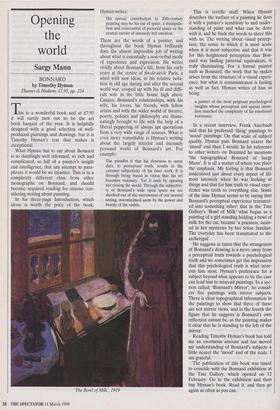Opening the world
Sargy Mann
BONNARD
his is a wonderful book and at £7.95 it will surely turn out to be the art book bargain of the year. It is helpfully designed with a good selection of well- produced paintings and drawings, but it is Timothy Hyman's text that makes it exceptional.
What Hyman has to say about Bonnard is so dazzlingly well informed, so rich and complicated, so full of a painter's insight and intelligence, that any attempt to para- phrase it would be an injustice. This is in a completely different class from other monographs on Bonnard, and should become required reading for anyone con- sidering writing about painting.
In his three-page Introduction, which alone is worth the price of the book, Hyman writes:
His special contribution to 20th-century painting may be his use of space, a manipula- tion and reinvention of pictorial space as the central carrier of intensely felt emotion.
These are the words of a painter, and throughout the book Hyman brilliantly does the almost impossible job of writing about what is essentially a non-verbal mode of experience and expression. He writes vividly about Bonnard's life, from his early years at the centre of fin-de-siecle Paris, a whirl with new ideas, to his relative isola- tion in old age during and after the second world war, cooped up with his ill and diffi- cult wife in the little house high above Cannes. Bonnard's relationships, with his wife, his lovers, his friends, with fellow artists and with the wider world of theatre, poetry, politics and philosophy are illumi- natingly brought to life with the help of a liberal peppering of always apt quotations from a very wide range of sources. What is even more remarkable is Hyman's writing about the largely interior and intensely personal world of Bonnard's art. For example:
The paradox is that his closeness to sense data, to perceptual truth, results in the extreme subjectivity of his later work. It is through being based in vision that his art becomes visionary. Yet it ends by opening not closing the world. Through the subjectivi- ty of Bonnard's wide open space we are shocked out of the narrowness of our normal seeing, overwhelmed anew by the power and beauty of the visible.
`The Bowl of Milk, 1919 This is terrific stuff. When Hyman describes the surface of a painting he does it with a painter's sensitivity to and under- standing of paint and what can be done with it, and he finds the words to share this with us. The writing about visual percep- tion, the sense in which it is most acute when it is most subjective and that it was for this heightened perception that Bon- nard was finding pictorial equivalents, is truly illuminating. For a formal painter such as Bonnard, the work that he makes arises from the structure of a visual experi- ence, but what is communicated is feeling as well as fact. Hyman writes of him as being
a painter of the most poignant psychological insights whose perceptual and spatial inven- tion matched the complexity of his emotional resonance.
In a recent interview, Frank Auerbach said that he preferred 'thing' paintings to `mood' paintings. On that scale of subject quality, Hyman puts Bonnard nearer the `mood' end than I would. In his reference to other writers on Bonnard he mentions `the topographical Bonnard of Sargy Mann'. It is all a matter of where you place the emphasis. My feeling is that Bonnard understood just about every aspect of life most intensely when he was looking at things and that for him truth to visual expe- rience was truth to everything else. Some of the time Hyman seems to be saying that Bonnard's perceptual experience transmut- ed into something other; that in the Tate Gallery's 'Bowl of Milk' what began as a painting of a girl standing holding a bowl of milk for the cat, became 'a priestess, assist- ed in her mysteries by her feline familiar. The everyday has been transmuted to the archetypal'.
He suggests at times that the strangeness of Bonnard's drawing is a move away from a perceptual truth towards a psychological truth and we sometimes get the impression that this psychological truth is what inter- ests him most. Hyman's preference for a subject beyond what appears to be the case can lead him to misread paintings. In a sec- tion called, `Bonnard's Mirror', he consid- ers five paintings with mirror subjects. There is clear topographical information in the paintings to show that three of these are not mirror views, and in the fourth the figure that he suggests is Bonnard's own reflection cannot be, as the painting makes it clear that he is standing to the left of the mirror.
Reading Timothy Hyman's book has told me an enormous amount and has moved my understanding of Bonnard's subjects a little nearer the 'mood' end of the scale. I am grateful.
The publication of this book was timed to coincide with the Bonnard exhibition at the Tate Gallery, which opened on 12 February. Go to the exhibition and then buy Hyman's book. Read it, and then go again as often as you can.


































































 Previous page
Previous page